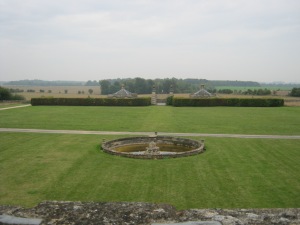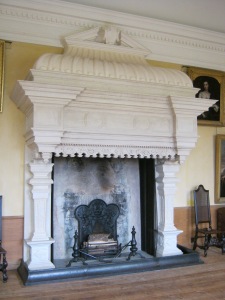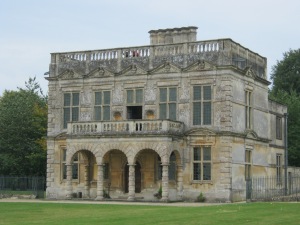When I mentioned to a long-standing Trust member that I was going to Lodge Park, his response was ‘never heard of it’, which was perhaps not the most auspicious of beginnings! However, I would still recommend a visit to anyone passing by (Fridays, Saturdays and Sundays only) as it does not take too long to view and has an interesting story to tell.
Lodge Park is on the Sherborne Estate (also owned by the Trust, although they do not own Sherborne House itself) and was built by one John ‘Crump’ Dutton for a very unusual purpose, i.e. as a grandstand from which he and his friends could watch and gamble on deer coursing. It appears that the Crump added to John Dutton’s name may have been due to his hunchback and it was this that led to his love of alternative sporting pursuits as he was not able to take part in anything more physical. He decided to try something more adventurous than card-playing and created a mile-long deer course with high walls on either side and a grandstand towards the end from where the gamblers could see the result of the race between the two dogs chasing the deer. It is actually a very eye-catching building, not just because of its architecture (said to have been inspired by the work of Inigo Jones and reminiscent of the Banqueting House in London’s Whitehall) but also because of its location, standing as it does all alone in an expanse of grassland.
 The visitor to Lodge Park is allowed to climb to the balcony and then all the way up to the roof to survey the views that the gamblers would have had of the course. Today, trees have blocked the view of much of the route, which would have run from the A40 to the north, finishing not far from the grandstand at a large ditch that the deer would jump and the dogs would not be able to. In this way, the deer could then return to the park and the dogs could be caught and rewarded (or not as the case may be!). On some occasions, however, it would appear that the deer was not so lucky and that the high stakes gamblers demanded blood at the end of their sport. My soapbox is just sitting there waiting for me to climb on and vent my bile on bloodthirsty ‘sportspeople’ and I’m itching to do so, but if I start I may not be able to stop, so deep breath…
The visitor to Lodge Park is allowed to climb to the balcony and then all the way up to the roof to survey the views that the gamblers would have had of the course. Today, trees have blocked the view of much of the route, which would have run from the A40 to the north, finishing not far from the grandstand at a large ditch that the deer would jump and the dogs would not be able to. In this way, the deer could then return to the park and the dogs could be caught and rewarded (or not as the case may be!). On some occasions, however, it would appear that the deer was not so lucky and that the high stakes gamblers demanded blood at the end of their sport. My soapbox is just sitting there waiting for me to climb on and vent my bile on bloodthirsty ‘sportspeople’ and I’m itching to do so, but if I start I may not be able to stop, so deep breath…
With no animal rights activists to upset their pursuits, the 17th century gentlefolk spent many years visiting Lodge Park for their entertainment and the guidebook features a list of the ‘articles and orders of the paddock course’ so the practice of deer coursing at the site was clearly established enough to be well regulated with strict rules so as to avoid disputes between gamblers.
 In the 18th century, many changes were made to the Lodge and the surrounding parkland, with Charles Bridgeman, the greatest landscaper of his day and a pioneer of the wilder landscaping that was later the purview of Capability Brown, taking on the project. The building itself also changed considerably over the next 180 years, even being given an extra storey at one time, so when the Trust finally took charge, it was a challenging task to try to restore the property to its deer-coursing days. As a result, much of what you will see inside Lodge Park, including such important features as the staircase and chimneypiece in the Great Room, are informed re-creations of what was once there.
In the 18th century, many changes were made to the Lodge and the surrounding parkland, with Charles Bridgeman, the greatest landscaper of his day and a pioneer of the wilder landscaping that was later the purview of Capability Brown, taking on the project. The building itself also changed considerably over the next 180 years, even being given an extra storey at one time, so when the Trust finally took charge, it was a challenging task to try to restore the property to its deer-coursing days. As a result, much of what you will see inside Lodge Park, including such important features as the staircase and chimneypiece in the Great Room, are informed re-creations of what was once there.
Here’s a little advice for those thinking of visiting. When you arrive you will have to push the front door hard to get in, it weighs a ton and can’t be opened without a lot of loud creaking. Also, for those of you who don’t want to sit and read a dry guidebook, there is an introductory video about the grandstand in a side room off the entrance hall. Anyone scared of heights might also want to forgo the trip to the roof as the parapet isn’t the highest and you will have to walk on sometimes wobbly boards.
I can’t finish without mentioning the 7th Baron Sherborne and his wife, who appear to have been a decidedly eccentric pair. They both flew planes and were known to have landed on the deer course occasionally as it made an ideal runway. When Ralph, their mechanic died, they politely instructed Betty, his widow and the family’s cook-housekeeper, to marry Bill from the village, coincidentally an excellent mechanic! When the baroness died, Baron Sherborne then told Betty she should divorce Bill and marry him, but this time she wasn’t so obliging. Betty sounds like something of a character herself and held the belief that ‘Crumpy’ was still haunting the house. She and Bill were the last residents at Lodge Park, having inherited a life tenancy from the Baron, and only left in 1992 so the Trust owned the building for ten years before it could start work on it.
Today, no one lives in the Lodge but one of the gatehouses (added in the late 1800s) is available to rent as a holiday cottage. And if anyone wants to host their own gambling party, Lodge Park is available for hire (although I’d advise against deer coursing… not only is it illegal but most of the course is now farmland!).
Highlights: The Great Room with its reconstructed chimney piece and views of the course
Refreshments: Cup of tea (hint: if you have a takeaway tea, the paper cup is about twice the size of the china cups but costs the same!)
Purchase(s): Guidebook
Companion(s): None

